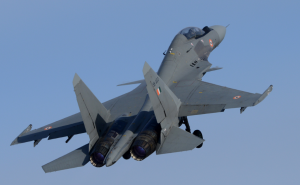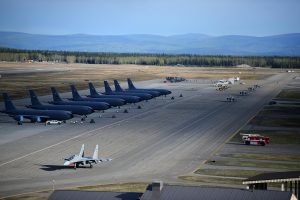2016-05-18 This year, the Indian Air Force flew to Alaska for the next round of Red Flag Exercises in 2016.
As Peter van den Berg commented in his article on Indian participation in the exercise:
“The decision to take part in the RF-A became definite in 2015.
The units have been training since November of that year in order to be prepared for the rathe difficult and complex exercise that RF-A is….
The Indians took a rather long route to get to Alaska.
That was denied upon based on weather condition sand accessibility along the route.”
The first stop was Bahrain, then Egypt, then Istres (France), then Beja and Lajes to Canada. Stopovers were made in Canada on the way to Alaska.

According to a USAF article published on May 13, 2016 written by Tech. Sgt. Steven R. Doty, 354th Fighter Wing:
RED FLAG-Alaska is a series of Pacific Air Forces commander-directed field training exercises for U.S. and partner nation forces, enabling joint and international units to exchange tactics, techniques and procedures while improving interoperability in a realistic threat environment.
With more than 75 aircraft and 1,400 participants, RF-A 16-1 featured a strategic — and rare — partnership with the Indian Air Force and two of their specific airframes; the Sukhoi SU-30MK, a twinjet multi-role air superiority fighter and the SEPECAT Jaguar, an Anglo-French jet-attack aircraft.
U.S. Air Force Colonel Brian Toth, 354th Operations Group commander, attributes participation of foreign military forces to the overall success of RF-A exercises.
“Through the initial planning meetings for each RED FLAG iteration, we discuss the end goals of each exercise and it is up to those countries’ representatives to acknowledge which missions would most benefit their particular needs at that time,” Toth said. “
However, the realistic training environment we aim to provide each iteration is only made possible with the participation of our partners and the hard work they put in throughout the exercise.”
Among the key highlights of the 2016 Red Flag in which India participated are the following according to an Indian observer:
- A team of over 170 Indian Air Force personnel was part of the exercises.
- The Indian Air Force flew 10 aircraft: four Su-30MKIs, four Jaguars and two IL-78 aerial refuelling tankers.
- The objective of this inter-continental deployment was to showcase the IAF’s capability in undertaking integrated air ops and to imbibe operational lessons from the exercise engagements.
- During the exercise, IAF also flew as a part of the Red Force (simulated as the Defensive force component fighting to protect own airspace and assets) alongside the Aggressors which was a first of its kind.
- The IAF Jaguars DARIN II undertook integrated strike missions dropping practice bombs over the world renowned JPARC Air to Ground Range.
- The temperatures were sub-zero during a large part of the exercise.

Peter van den Berg added that:
“A total of 10 missions were flown by both the SU-MKI and the Jaguars: five in the first and five in the second week of the Red Flag Exercise.
The Jaguars were usually classified under the blue team and the SU-30MKIs had a supporting, defensive task.
Main challenges for thse pilots were training with other foreign units and the intensive program.
Another challenge was to turn the learning effect and inform from the mission debriefings into knowledge to be brought back home to India.”
An illustration of the impact of Red Flag upon coalition operations can be seen with regard to Indian’s Air Force contingents from Red Flag coming back to the region to expand their working relationship with the UAE, notably with the UAE’s Block 60 F-16s.
According to Pakistan Defence:
Until recently, the Indian Air Force (IAF) planned for the possibility of United Arab Emirates (UAE) supplying up to a squadron of F-16 fighters to boost the Pakistan Air Force (PAF) in an Indo-Pakistan conflict.
Now, dramatically signalling the transformed relationship between New Delhi and Abu Dhabi, an IAF contingent returning to India next month from the on-going Red Flag exercise in the US will train with the UAE air force.
Its pilots fly the world’s most potent F-16s, the Block 60 version, superior even to US Air Force F-16s and to the Block 50/52 version that Washington supplies Pakistan…..
Growing defence and counter-terrorism cooperation between India and UAE has been catalysed by Abu Dhabi’s sharp U-turn from the time PAF pilots trained its air force and retired PAF technicians maintained its Mirage III and F-16 fighters.
This has been catalysed by the radical threat posed by the Islamic State of Iraq and Syria (ISIS).
During Prime Minister Narendra Modi’s visit to UAE last August, the two countries forged a “comprehensive strategic partnership”.
On its heels came the February visit to New Delhi of the Crown Prince of Abu Dhabi, Mohammed bin Zayed al Nahyan, when “the two renewed their commitment to strengthening the existing cooperation in training, joint exercises, and participation in defence exhibitions, as well as in identifying opportunities to cooperate on the production of defence equipment in India”.
The UAE has detected and deported terrorist sympathisers from the two million Indians working in that country, handing them over to Indian authorities. al Nahyan, visiting soon after the terrorist attack on the Pathankot Air Base this year, condemned cross-border terrorism.
If the UAE is a new friend, Oman has long been India’s most steadfast partner in West Asia.
Muscat and New Delhi signed a military protocol in 1972, and the two air forces together conducted Exercise Eastern Bridge in 2009 in Oman, and in 2011 in India.
This incorporated the common Jaguar fighter, which both operated until Oman retired its Jaguars in 2014 and bought the Eurofighter. Until then, Jaguar spares built by HAL were sold to Oman. With the IAF looking to extend the service life of its six Jaguar squadrons by fitting in new engines and avionics, Oman’s 24 retired Jaguars could be of interest to the IAF.

